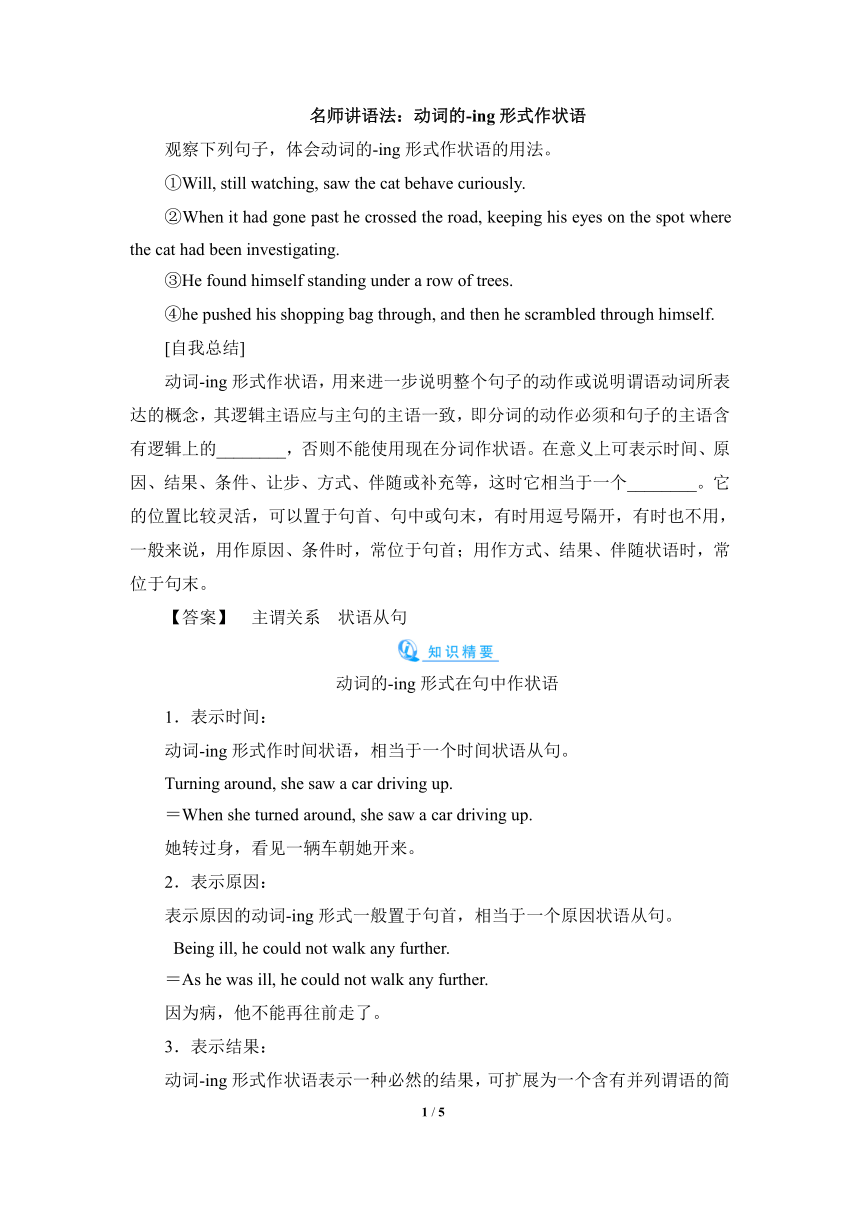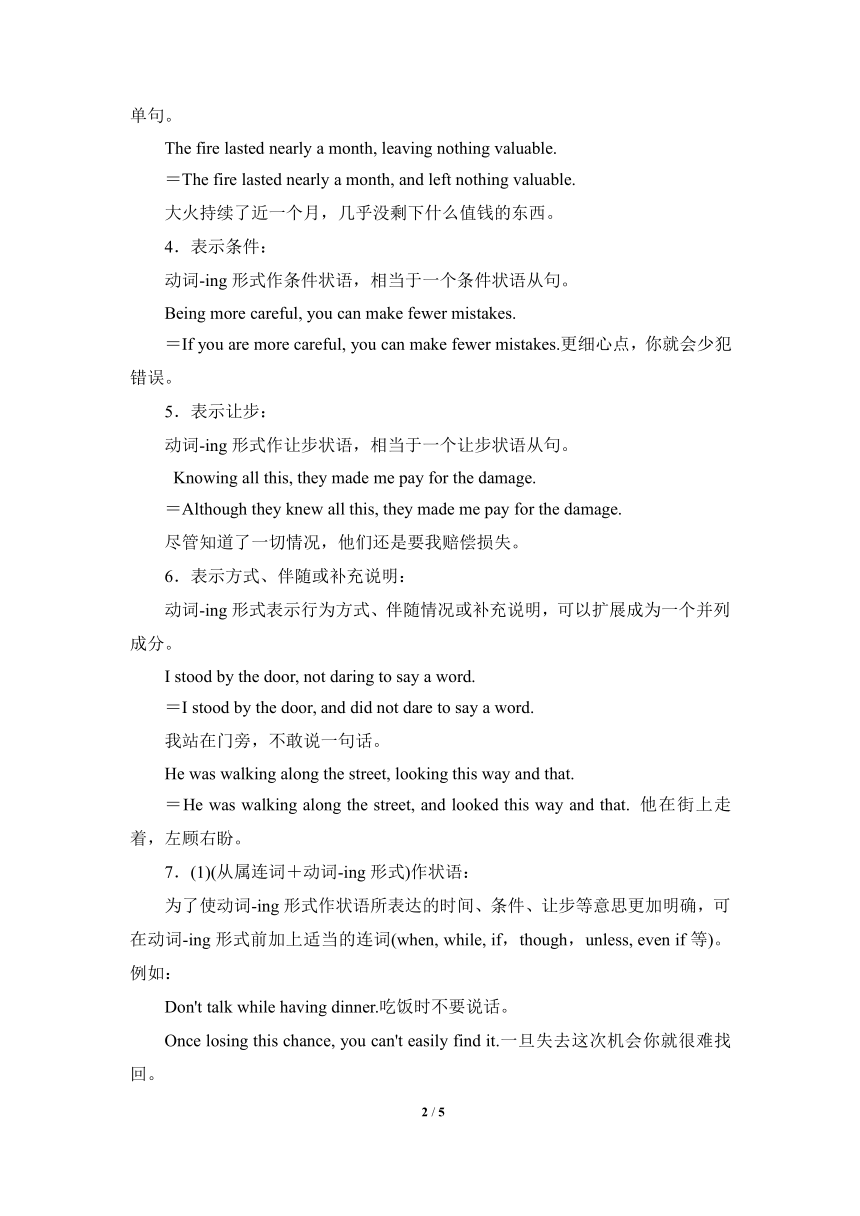外研版 选修6 Module 2 Fantasy Literature – Philip Pullman 名师讲语法:动词的ing形式作状语学案(含答案)
文档属性
| 名称 | 外研版 选修6 Module 2 Fantasy Literature – Philip Pullman 名师讲语法:动词的ing形式作状语学案(含答案) |  | |
| 格式 | doc | ||
| 文件大小 | 52.5KB | ||
| 资源类型 | 教案 | ||
| 版本资源 | 外研版 | ||
| 科目 | 英语 | ||
| 更新时间 | 2023-02-17 21:29:53 | ||
图片预览


文档简介
名师讲语法:动词的 ing形式作状语
观察下列句子,体会动词的 ing形式作状语的用法。
①Will, still watching, saw the cat behave curiously.
②When it had gone past he crossed the road, keeping his eyes on the spot where the cat had been investigating.
③He found himself standing under a row of trees.
④he pushed his shopping bag through, and then he scrambled through himself.
[自我总结]
动词 ing形式作状语,用来进一步说明整个句子的动作或说明谓语动词所表达的概念,其逻辑主语应与主句的主语一致,即分词的动作必须和句子的主语含有逻辑上的________,否则不能使用现在分词作状语。在意义上可表示时间、原因、结果、条件、让步、方式、伴随或补充等,这时它相当于一个________。它的位置比较灵活,可以置于句首、句中或句末,有时用逗号隔开,有时也不用,一般来说,用作原因、条件时,常位于句首;用作方式、结果、伴随状语时,常位于句末。
【答案】 主谓关系 状语从句
动词的 ing形式在句中作状语
1.表示时间:
动词 ing形式作时间状语,相当于一个时间状语从句。
Turning around, she saw a car driving up.
=When she turned around, she saw a car driving up.
她转过身,看见一辆车朝她开来。
2.表示原因:
表示原因的动词 ing形式一般置于句首,相当于一个原因状语从句。
Being ill, he could not walk any further.
=As he was ill, he could not walk any further.
因为病,他不能再往前走了。
3.表示结果:
动词 ing形式作状语表示一种必然的结果,可扩展为一个含有并列谓语的简单句。
The fire lasted nearly a month, leaving nothing valuable.
=The fire lasted nearly a month, and left nothing valuable.
大火持续了近一个月,几乎没剩下什么值钱的东西。
4.表示条件:
动词 ing形式作条件状语,相当于一个条件状语从句。
Being more careful, you can make fewer mistakes.
=If you are more careful, you can make fewer mistakes.更细心点,你就会少犯错误。
5.表示让步:
动词 ing形式作让步状语,相当于一个让步状语从句。
Knowing all this, they made me pay for the damage.
=Although they knew all this, they made me pay for the damage.
尽管知道了一切情况,他们还是要我赔偿损失。
6.表示方式、伴随或补充说明:
动词 ing形式表示行为方式、伴随情况或补充说明,可以扩展成为一个并列成分。
I stood by the door, not daring to say a word.
=I stood by the door, and did not dare to say a word.
我站在门旁,不敢说一句话。
He was walking along the street, looking this way and that.
=He was walking along the street, and looked this way and that. 他在街上走着,左顾右盼。
7.(1)(从属连词+动词 ing形式)作状语:
为了使动词 ing形式作状语所表达的时间、条件、让步等意思更加明确,可在动词 ing形式前加上适当的连词(when, while, if,though,unless, even if等)。例如:
Don't talk while having dinner.吃饭时不要说话。
Once losing this chance, you can't easily find it.一旦失去这次机会你就很难找回。
(2)要避免无依着(无逻辑主语)动词 ing形式:
动词 ing形式作状语时,其逻辑主语必须与句子的主语一致,如果状语与主语不一致,可给从句加上主语,变成主从复合句。例如:
【错误】While reading the book, the telephone rang.
【正确】While she was reading the book, the telephone rang.
她看书的时候,电话铃响了。(reading的动作不是the telephone发出)
【错误】Looking out through the window, the garden was beautiful.
【正确】Looking out through the window, we found a beautiful garden.
从窗户里,我们看见一个漂亮的花园。(looking的动作不是garden发出)
(3)独立动词 ing形式作状语:
英语中有些动词 ing形式,如generally speaking(一般来说), judging from(从……判断),considering(考虑到), supposing(如果……)等,它们作状语时的逻辑主语可以和句子的主语不一致。这种形式已经成为固定的用法。例如:
Supposing he is ill, who will do the work
假如他病了,谁来做这工作呢?
Generally speaking, boys are more interested in science than girls.
一般来说,男孩比女孩对科学更感兴趣。
【注意】 a.动词 ing形式作状语,当句子的谓语动词和动词 ing形式的动词所表动作在时间上几乎同时发生时,用doing作状语,;若动词 ing形式动作发生在句子谓语动词所表示的动作之前,用其完成时having done 作状语,;动词 ing形式的否定形式为:not doing 或者not having done。
b.有一些固定的动词 ing形式作状语,这就是独立成分。
c.当句子主语和动词 ing形式的主语不一致时,则不可省略动词 ing形式的主语。这时可用独立主格结构,即:带有逻辑主语的动词 ing形式作状语;或者用with 复合结构作伴随状语。
Ⅰ.单项填空
1.(2012·江苏高考)________ an important decision more on emotion than on reason, you will regret it sooner or later.
A.Based B.Basing C.Base D.To base
【解析】 非谓语动词用法。动词现在分词做状语,动词base与逻辑主语you之间构成主谓关系,所以用现在分词作状语,故选B项。
【答案】 B
2.(2012·重庆高考)________to work overtime that evening, I missed a wonderful film.
A.Having been asked B.To ask
C.Having asked D.To be asked
【解析】 非谓语动词用法。逗号前为原因状语,空白处与句子的主语为逻辑上的动宾关系,由此可排除表示主动关系的B和C选项,D选项常作目的和结果状语,不作原因状语,也可排除,而A选项为现在分词完成式的被动形式,可作时间状语、原因状语、结果状语、伴随状语等。因此,正确答案为A选项。
【答案】 A
3.(2013·四川高考)________ which university to attend, the girl asked her teacher for advice.
A.Not knowing B.Knowing not
C.Not known D.Known not
【解析】 考查非谓语动词。主语the girl与非谓语动词know之间为主动关系,故用现在分词;且非谓语动词的否定式应在其前加否定词。据此可知答案为A。此处分词Not knowing在句中作原因状语。
【答案】 A
4.(2013·重庆高考)When I was little, my mother used to sit by my bed, ________me stories till I fell asleep.
A.having told B.telling C.told D.to tell
【解析】 考查非谓语动词。此处非谓语动词tell与主语my mother为主动关系,故用telling作伴随状语。
【答案】 B
5.(2013·山东高考)________ at the cafeteria before, Tina didn't want to eat there again.
A.Having eaten B.To eat C.Eat D.Eating
【解析】 考查非谓语动词。句意为:因为以前曾经在自助餐厅吃过,Tina再也不想在那儿吃了。动词eat与主语Tina之间为主动关系,再根据句中before可知需强调eat这个动作发生在主句谓语动词之前,可知用现在分词完成形式Having eaten。
【答案】 A
Ⅱ.用括号内动词的正确形式填空
1.________(not recognize)the voice, he refused to give the person his address.
2.__________(be)so angry, he couldn't go to sleep.
3.___________(hold)guns, the soldiers rushed out.
4.The children went out of the school _______(talk) and _______(laugh)
5.The fish can eat a man in a few minutes, ___________(leave) only the bones.
6.____________(walk)along the valley, we came across a large cave.
7._________(not know) his telephone number, I couldn't get in touch with him.
8.I ran out of the house __________(shout).
9.____________(arrive) at the building site she found them busy laying bricks.
10.When____________(leave)the airport, they waved again and again to us.
【答案】 1.Not recognizing 2.Being 3.Holding
4.talking; laughing 5.leaving 6.Walking 7.Not knowing 8.shouting 9.Arriving 10. leaving
PAGE
1 / 5
观察下列句子,体会动词的 ing形式作状语的用法。
①Will, still watching, saw the cat behave curiously.
②When it had gone past he crossed the road, keeping his eyes on the spot where the cat had been investigating.
③He found himself standing under a row of trees.
④he pushed his shopping bag through, and then he scrambled through himself.
[自我总结]
动词 ing形式作状语,用来进一步说明整个句子的动作或说明谓语动词所表达的概念,其逻辑主语应与主句的主语一致,即分词的动作必须和句子的主语含有逻辑上的________,否则不能使用现在分词作状语。在意义上可表示时间、原因、结果、条件、让步、方式、伴随或补充等,这时它相当于一个________。它的位置比较灵活,可以置于句首、句中或句末,有时用逗号隔开,有时也不用,一般来说,用作原因、条件时,常位于句首;用作方式、结果、伴随状语时,常位于句末。
【答案】 主谓关系 状语从句
动词的 ing形式在句中作状语
1.表示时间:
动词 ing形式作时间状语,相当于一个时间状语从句。
Turning around, she saw a car driving up.
=When she turned around, she saw a car driving up.
她转过身,看见一辆车朝她开来。
2.表示原因:
表示原因的动词 ing形式一般置于句首,相当于一个原因状语从句。
Being ill, he could not walk any further.
=As he was ill, he could not walk any further.
因为病,他不能再往前走了。
3.表示结果:
动词 ing形式作状语表示一种必然的结果,可扩展为一个含有并列谓语的简单句。
The fire lasted nearly a month, leaving nothing valuable.
=The fire lasted nearly a month, and left nothing valuable.
大火持续了近一个月,几乎没剩下什么值钱的东西。
4.表示条件:
动词 ing形式作条件状语,相当于一个条件状语从句。
Being more careful, you can make fewer mistakes.
=If you are more careful, you can make fewer mistakes.更细心点,你就会少犯错误。
5.表示让步:
动词 ing形式作让步状语,相当于一个让步状语从句。
Knowing all this, they made me pay for the damage.
=Although they knew all this, they made me pay for the damage.
尽管知道了一切情况,他们还是要我赔偿损失。
6.表示方式、伴随或补充说明:
动词 ing形式表示行为方式、伴随情况或补充说明,可以扩展成为一个并列成分。
I stood by the door, not daring to say a word.
=I stood by the door, and did not dare to say a word.
我站在门旁,不敢说一句话。
He was walking along the street, looking this way and that.
=He was walking along the street, and looked this way and that. 他在街上走着,左顾右盼。
7.(1)(从属连词+动词 ing形式)作状语:
为了使动词 ing形式作状语所表达的时间、条件、让步等意思更加明确,可在动词 ing形式前加上适当的连词(when, while, if,though,unless, even if等)。例如:
Don't talk while having dinner.吃饭时不要说话。
Once losing this chance, you can't easily find it.一旦失去这次机会你就很难找回。
(2)要避免无依着(无逻辑主语)动词 ing形式:
动词 ing形式作状语时,其逻辑主语必须与句子的主语一致,如果状语与主语不一致,可给从句加上主语,变成主从复合句。例如:
【错误】While reading the book, the telephone rang.
【正确】While she was reading the book, the telephone rang.
她看书的时候,电话铃响了。(reading的动作不是the telephone发出)
【错误】Looking out through the window, the garden was beautiful.
【正确】Looking out through the window, we found a beautiful garden.
从窗户里,我们看见一个漂亮的花园。(looking的动作不是garden发出)
(3)独立动词 ing形式作状语:
英语中有些动词 ing形式,如generally speaking(一般来说), judging from(从……判断),considering(考虑到), supposing(如果……)等,它们作状语时的逻辑主语可以和句子的主语不一致。这种形式已经成为固定的用法。例如:
Supposing he is ill, who will do the work
假如他病了,谁来做这工作呢?
Generally speaking, boys are more interested in science than girls.
一般来说,男孩比女孩对科学更感兴趣。
【注意】 a.动词 ing形式作状语,当句子的谓语动词和动词 ing形式的动词所表动作在时间上几乎同时发生时,用doing作状语,;若动词 ing形式动作发生在句子谓语动词所表示的动作之前,用其完成时having done 作状语,;动词 ing形式的否定形式为:not doing 或者not having done。
b.有一些固定的动词 ing形式作状语,这就是独立成分。
c.当句子主语和动词 ing形式的主语不一致时,则不可省略动词 ing形式的主语。这时可用独立主格结构,即:带有逻辑主语的动词 ing形式作状语;或者用with 复合结构作伴随状语。
Ⅰ.单项填空
1.(2012·江苏高考)________ an important decision more on emotion than on reason, you will regret it sooner or later.
A.Based B.Basing C.Base D.To base
【解析】 非谓语动词用法。动词现在分词做状语,动词base与逻辑主语you之间构成主谓关系,所以用现在分词作状语,故选B项。
【答案】 B
2.(2012·重庆高考)________to work overtime that evening, I missed a wonderful film.
A.Having been asked B.To ask
C.Having asked D.To be asked
【解析】 非谓语动词用法。逗号前为原因状语,空白处与句子的主语为逻辑上的动宾关系,由此可排除表示主动关系的B和C选项,D选项常作目的和结果状语,不作原因状语,也可排除,而A选项为现在分词完成式的被动形式,可作时间状语、原因状语、结果状语、伴随状语等。因此,正确答案为A选项。
【答案】 A
3.(2013·四川高考)________ which university to attend, the girl asked her teacher for advice.
A.Not knowing B.Knowing not
C.Not known D.Known not
【解析】 考查非谓语动词。主语the girl与非谓语动词know之间为主动关系,故用现在分词;且非谓语动词的否定式应在其前加否定词。据此可知答案为A。此处分词Not knowing在句中作原因状语。
【答案】 A
4.(2013·重庆高考)When I was little, my mother used to sit by my bed, ________me stories till I fell asleep.
A.having told B.telling C.told D.to tell
【解析】 考查非谓语动词。此处非谓语动词tell与主语my mother为主动关系,故用telling作伴随状语。
【答案】 B
5.(2013·山东高考)________ at the cafeteria before, Tina didn't want to eat there again.
A.Having eaten B.To eat C.Eat D.Eating
【解析】 考查非谓语动词。句意为:因为以前曾经在自助餐厅吃过,Tina再也不想在那儿吃了。动词eat与主语Tina之间为主动关系,再根据句中before可知需强调eat这个动作发生在主句谓语动词之前,可知用现在分词完成形式Having eaten。
【答案】 A
Ⅱ.用括号内动词的正确形式填空
1.________(not recognize)the voice, he refused to give the person his address.
2.__________(be)so angry, he couldn't go to sleep.
3.___________(hold)guns, the soldiers rushed out.
4.The children went out of the school _______(talk) and _______(laugh)
5.The fish can eat a man in a few minutes, ___________(leave) only the bones.
6.____________(walk)along the valley, we came across a large cave.
7._________(not know) his telephone number, I couldn't get in touch with him.
8.I ran out of the house __________(shout).
9.____________(arrive) at the building site she found them busy laying bricks.
10.When____________(leave)the airport, they waved again and again to us.
【答案】 1.Not recognizing 2.Being 3.Holding
4.talking; laughing 5.leaving 6.Walking 7.Not knowing 8.shouting 9.Arriving 10. leaving
PAGE
1 / 5
